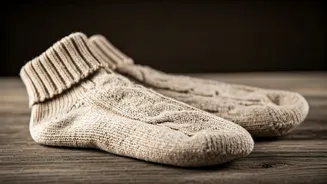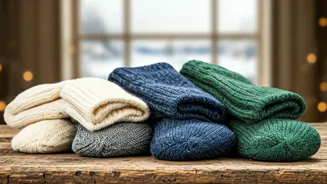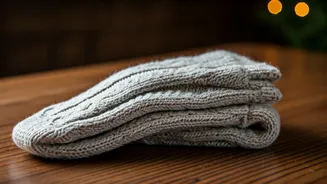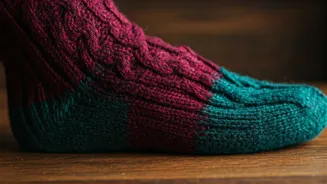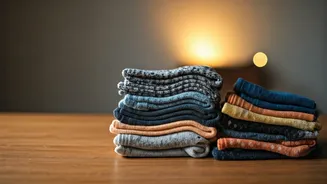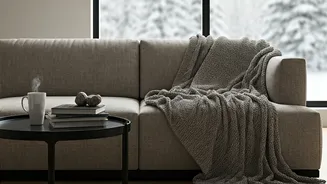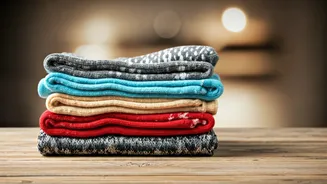Material Matters: The Foundation
The cornerstone of any effective winter sock lies in its material composition. Wool, particularly merino wool, stands out as a top choice due to its exceptional
warmth-retaining properties and moisture-wicking capabilities. Merino wool excels at keeping feet dry and warm by pulling sweat away from the skin. Synthetic fibers, such as polyester and acrylic, also play a significant role. These are often blended with natural fibers to improve durability and enhance moisture management. They provide good insulation and quick-drying characteristics. Cotton socks, while comfortable in warmer seasons, are generally less suitable for winter. Cotton retains moisture, leading to cold and clammy feet in cold weather conditions. Therefore, when selecting winter socks, prioritize materials known for their ability to trap heat and manage moisture effectively. Consider wool or synthetic blends for the best results.
Construction: Weave and Design
The construction of a winter sock significantly influences its warmth and comfort. The density of the knit is a key factor; thicker knits trap more air, providing superior insulation. Look for socks with a dense weave, often indicated by a higher thread count. The design of the sock also impacts performance. Socks with a reinforced heel and toe are more durable and provide added protection against wear and tear. Seamless designs minimize friction and reduce the risk of blisters, crucial for comfort during extended wear. Consider the overall fit, ensuring the sock comfortably hugs the foot without being too tight, which can restrict circulation and make your feet feel colder. Features such as a cushioned footbed can also enhance comfort and provide extra insulation against cold ground surfaces. Pay close attention to the construction details to ensure that you select socks engineered for optimal warmth and durability.
Height and Fit: Tailored Warmth
The height and fit of winter socks are crucial in providing the right level of warmth and coverage. Crew socks are a versatile option, offering coverage up to the mid-calf, making them suitable for everyday wear and various activities. Over-the-calf socks extend higher, providing additional warmth and protection against the cold for those wearing boots or venturing into deep snow. The fit of the sock must be snug but not restrictive. The sock should sit smoothly against your skin without bunching or creating pressure points. Socks that are too tight can cut off circulation, leading to cold feet. Conversely, socks that are too loose can slip and cause discomfort. Select the height and fit that best suits your intended activities and footwear to ensure maximum comfort and thermal efficiency. Consider pairing your socks with boots or shoes to ensure a perfect fit.
Usage Scenarios: Purpose-Built Socks
The ideal winter sock choice varies depending on the intended use. For casual everyday wear, wool blend crew socks provide a good balance of warmth, comfort, and breathability. For outdoor activities like hiking or skiing, specialized socks with moisture-wicking and extra cushioning are essential. These socks are often constructed from merino wool blends or synthetic fibers designed to keep feet dry and warm in demanding conditions. For very cold climates or extreme activities, consider thermal socks that offer multiple layers and enhanced insulation. These socks are engineered to trap heat and provide maximum protection against freezing temperatures. When selecting socks, consider the specific activities you'll be doing. This will help you choose socks that provide the right amount of warmth, protection, and performance to suit your needs.
Care and Maintenance: Longevity
Proper care and maintenance are essential to extend the lifespan and maintain the performance of your winter socks. Always follow the manufacturer's instructions for washing. Generally, it is best to wash wool socks in cold water on a gentle cycle. Use a mild detergent to preserve the fibers' integrity and avoid harsh chemicals that can damage the material. Avoid using bleach or fabric softeners, as these can reduce the socks' moisture-wicking ability. Air-drying your socks is recommended as heat can shrink or damage the fibers. If using a dryer, opt for a low heat setting. Storing your socks properly can also extend their life. Keep them in a cool, dry place away from direct sunlight. Consider rotating your sock pairs to reduce wear and tear. Following these care guidelines will ensure that your winter socks remain in good condition.




